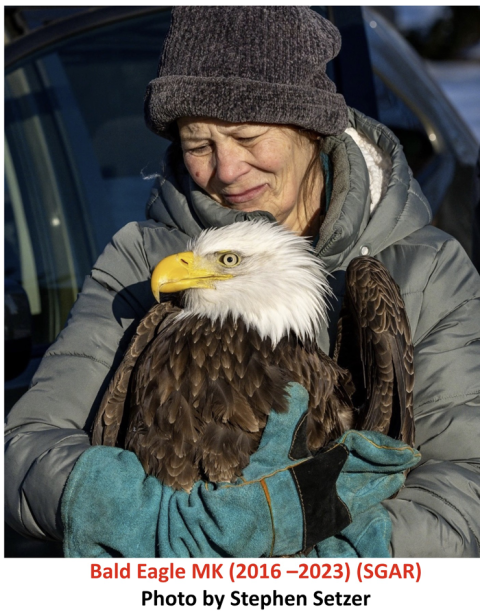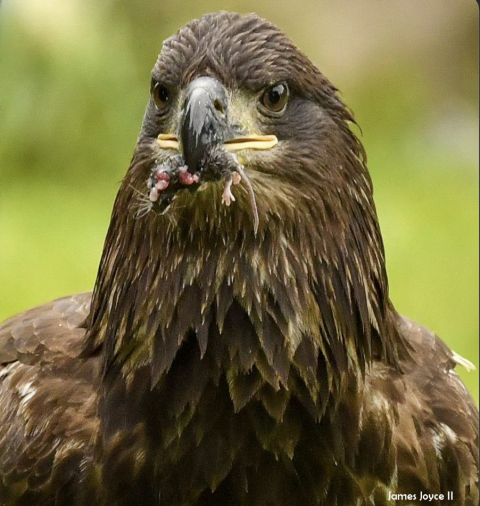Wildlife-Safe Alternatives to Harmful Rodent Poisons

Researchers and wildlife rehabbers have documented the deaths of hawks and owls from rodent poisons -- aka rodenticides -- over the past two decades. In the past five years, several New Hampshire Bald Eagles have been poisoned, according to NH Audubon. Now, alarmingly, mammalian predators such as fox and fisher are being poisoned, too. Recent necropsies by the NH Veterinary Diagnostic Laboratory at UNH found that 34 of 35 animals from throughout the state had been exposed to rodenticides, often the long-acting Second-Generation Anticoagulant Rodenticides (SGARs).
How Rodenticides Impact More than Rats
Rodent poisons can cause a deadly chain reaction throughout the food web:
- Chipmunks, squirrels and other non-target animals may consume the rodenticide directly.
- Scavengers like turkey vultures, crows and bald eagles may consume the toxic carcass of animals poisoned by rodenticides.
- Predators such as owls, hawks, fisher and fox may feed on live rodents that have ingested the rodenticide.
Rodents can consume a lethal dose of second-generation anticoagulants in one night of feeding but can consume more because death usually occurs 5-7 days after a lethal dose is consumed, according to the Environmental Protection Agency (EPA). Risk to predators and scavengers is higher because the amount of poison rodents consume over several days is greater, and second-generation anticoagulants persist in rodent carcasses much longer than first-generation anticoagulants.
Wildlife-Safe Alternatives to SGARs
Are there any raptor- and mammal-safe rat poisons? The answer is no. “If you are looking for a rodenticide that will target only mice and leave owls completely alone, there is currently no such miracle. All chemicals on the market to kill rodents are also toxic to birds and other non-target wildlife,” says Anna Morris, Director of Wildlife Ambassador Programs at the Vermont Institute of Natural Science.
For a more wildlife-safe alternative, first ask any commercial exterminators you use to NOT use SGARs or poison for rodent control.
Secondly, experts recommend using Integrated Pest Management (IPM), a science-based, non-chemical approach to rodent control. UNH Extension Field Specialist Rachel Maccini cites five IPM alternatives to rodenticides:
- Environmental Control. Rodents won’t stick around if there’s nothing to eat! Remove food sources – bird feeders, pet food and compost. Cover garbage cans, harvest garden produce quickly, and never leave pet food out for long periods. Engage in routine cleaning and sanitation.
- Exclusion. Rodents can fit through holes as small as a quarter. Keep them out of your space by filling all holes and closing gaps under doors and between windows. No opening should be larger than 0.25 inches. Keep all feed covered in metal containers (plastic can be chewed through). Install door sweeps on all exterior doors.
- Trapping. Snap Traps kill quickly and are economical. Electronic traps kill quickly with an electric shock. Other non-toxic approaches include Co2, rodent contraceptives and dry ice.
- Predators. Make your property owl- and hawk-friendly. Attract owls with owl boxes and large dead trees to encourage natural rodent control. A single Eastern Screech Owl can easily consume more than 1,000 mice in a single year, according to Smithsonian’s National Zoo. Parent hawks and chicks can eat 1000 mice in a nesting season, according to Dr. Charles Clarkson, Audubon RI.
- Habitat Modification. Remove possible rodent shelter and nesting areas inside and outside your home. Trim bushes at your house foundation and move stacked wood and debris piles away from buildings to eliminate rodent hiding spots. Remove clutter both indoors and outdoors
In summary, UNH Extension’s Rachel Maccini says:
- Protect your family, pets and wildlife
- Prevention (barriers, food, garbage, holes) is the best control
- Instead of rodenticides, practice IPM for safer and longer-lasting rodent control solutions
For more information, go to https://nhaudubon.org/policy/rodenticides/
If you are interested in advocating to reduce the use of rodenticides in NH, please contact Carol Foss, NH Audubon Senior Advisor for Science and Policy, cfoss@nhaudubon.org.

Rodent-Proof Barn or Home Checklist
Structural Integrity
- All exterior gaps and holes are sealed (no openings larger than 1/4 inch).
- Door sweeps installed and intact on all exterior doors.
- Window screens are tight-fitting and without holes.
- Vents, pipes, and utility openings are sealed with metal mesh or rodent-proof materials.
- Roof and foundation are inspected for access points.
Sanitation and Storage
- All feed is stored in metal or rodent-proof containers with tight-fitting lids.
- Trash is sealed and removed regularly.
- Spilled grain, feed, or pet food is cleaned up promptly.
- Hay and bedding are stored off the floor and away from walls.
- No food or water left out overnight (including pet dishes).
Habitat Management
- Vegetation and brush are trimmed away from buildings.
- Woodpiles and debris are stored at least 18 inches off the ground and away from the structure.
- Compost is contained and managed properly.
- Bird feeders are placed away from structures.
Monitoring and Control
- Snap or box traps are placed and checked regularly in high-risk areas.
- Droppings, gnaw marks, or other signs of activity are monitored and recorded.
- Entry points or activity signs are reported and addressed immediately.